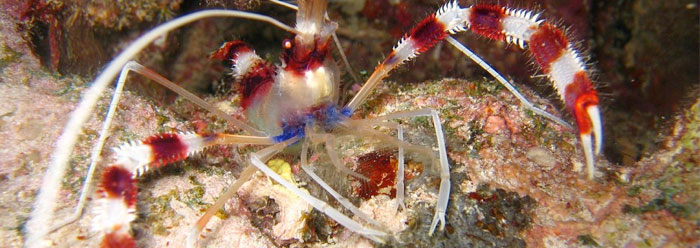Fossils seem to tell amazing stories about ancient animal life, but close inspection reveals that these stories differ from each other not because of different fossils, but because of different interpretations. Do the remarkable circumstances surrounding a newly discovered fossil arthropod tell two stories or just one?
A US team of paleontologists publishing in the Journal of Paleontology described a new fossil arthropod as belonging to a rare shrimp-like kind called stenopodideans.1 These marine animals have a huge set of third legs, whereas shrimp and lobsters have large first legs.
The fossil looks so much like a living stenopodidean that the study authors were easily able to identify it. But the really remarkable piece of this story is its geologic setting.
Based on fossil tree parts found in the same rocks, the research report argued that this stenopodidean specimen came from upper Devonian rocks in Pennsylvania. The extinct tree Archaeopteris had fern-like leaves and serves as an index fossil, identifying upper Devonian and lower Carboniferous strata.2 The conventional age for upper Devonian rocks hovers around 360 million years.
This new discovery blasts apart the idea that Stenopodidea "emerged" in the Cretaceous and has thus been living for only about 100 million years unchanged. In the study authors' words, the fossil from Pennsylvania "extends the geologic range" of these creatures by adding about 260 million years to their supposed duration on planet Earth.1
Some evolutionists refer to these gigantic hiatuses—where a fossil appears in one rock system and is absent from several intervening systems before popping up again—as "ghost lineages."3 Such a story invokes a tremendously improbable scenario: that 360 million years of mutations and natural selection had essentially no effect on countless generations of stenopodideans.
Can this fossil fit a more reasonable scenario?
For example, what would the biblical creation and Flood events have produced? First, according to Genesis creation, God made each animal to reproduce after its own kind. He did not create them with the ability to produce a different kind of animal even after many generations. In unwitting league with this expectation, the Journal of Paleontology study authors wrote, "The [Stenopodidea] specimen described herein contributes little to our understanding of decapod origins, but provides additional evidence that Devonian decapods were highly derived, consistent with our current understanding of the group at that time."1
In other words, this thing looks like it just popped up out of nowhere, with no known evolutionary precursor, and with all its parts fully formed right from its earliest fossil appearance.4
Second, according to Genesis, the Flood destroyed Earth and should thus have generated most of earth's water-deposited fossils, including this crustacean discovery from Pennsylvania. Accordingly, only weeks or months would have passed between stenopodideans getting deposited in Devonian rocks and other stenopodideans ending up in Cretaceous strata. No wonder these creatures do not look substantially different today after 360 million supposed years. Those long ages never took place.
It looks like different assumptions about the past drastically affect which story these Stenopodidea fossils fit. And those who assume millions of years of earth history are forced to tell a ghost story about these amazing crustacean fossils.
References
- Jones, W. T. et al. 2014. The first Paleozoic stenopodidean from the Huntley Mountain Formation (Devonian-Carboniferous) north-central Pennsylvania. Journal of Paleontology. 88 (6): 1251-1256.
- While this age-dating method seems reasonable on the surface, this new fossil highlights why it presents an irony at best and a completely fallacious procedure at worst. The procedure falls under the term "biostratigraphy," and first assumes that a certain animal lived and died within a specific time range often millions of years ago. It then assumes that every occurrence of that animal's fossil marks that same moment in ancient time. But if that animal lived long before or long after its supposed time range—even though known fossils don't yet show it—then it should not be used for dating. Similarly, until this find, a Stenopodidea fossil might have identified Cretaceous strata, but since these researchers describe Stenopodidea from a Devonian source, and since they still live today, they should not be used to identify time in rocks.
- Sherwin, F. 2010. The Strange Metaphysical World of Evolution. Acts & Facts. 39 (12): 16.
- As though to confirm the lack of an evolutionary history for these creatures, and thus unwittingly corroborate the concept that they were instead created, the Atlas of Crustacean Larvae recently wrote, "Stenopodideans have long been a source of interest and curiosity among decapod workers, as their relationship to other decapods is unclear," partly because their larvae develop into adults in unique ways. Goy, J.W. 2014. "Stenopodidea." In Martin, J.W., J. Olesen, and J.T. Hoeg, Eds. Atlas of Crustacean Larvae. Baltimore, MD: Johns Hopkins University Press, 245.
Image credit: Richard Ling. Adapted for use in accordance with federal copyright (fair use doctrine) law. Usage by ICR does not imply endorsement of copyright holders.
* Mr. Thomas is Science Writer at the Institute for Creation Research.
Article posted on December 4, 2014.
















